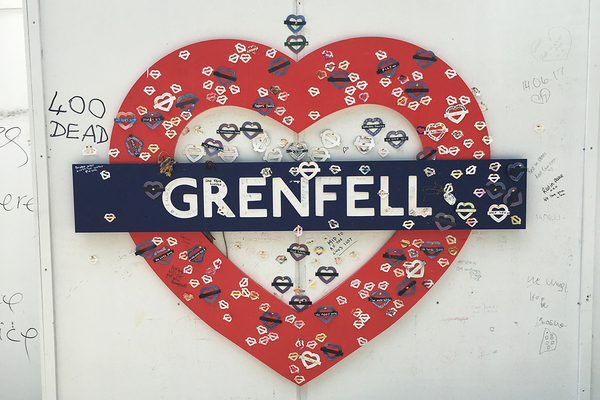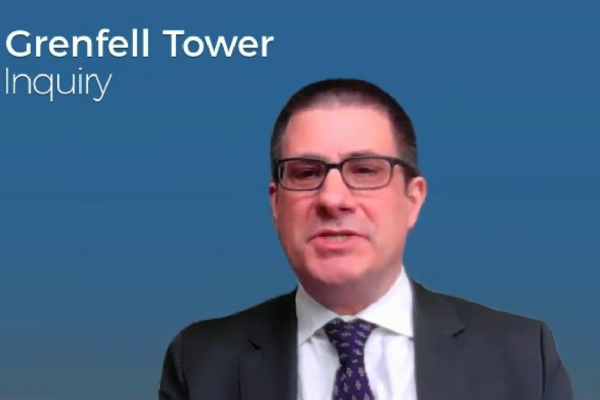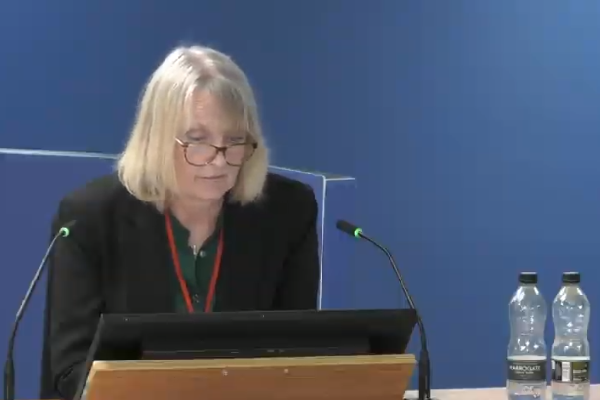Government-endorsed guidance is reason no plans were made for evacuating disabled Grenfell residents, KCTMO director says
The company that managed Grenfell Tower did not prepare plans to evacuate residents with disabilities during a fire due to its reliance on government-endorsed guidance, its former director of housing has told the inquiry.
Teresa Brown was grilled this morning about Kensington and Chelsea Tenant Management Organisation’s (KCTMO) lack of ‘personal emergency evacuation plans’, known as PEEPs, for vulnerable residents.
Asked why the organisation did not refer vulnerable residents for PEEPs before the blaze, Ms Brown said “because of our stay put policy we weren’t expecting to evacuate”.
Pressed on this, she cited guidance published by the Local Government Association (LGA) in 2011 titled ‘Fire safety in purpose-built blocks of flats’.
This guidance was commissioned by government in the aftermath of the Lakanal House fire in 2009 and recommended against the development of PEEPs, saying it is “usually unrealistic to expect landlords… to have in place special arrangements” to evacuate those with disabilities.
“I think it’s all comes back to… central advice that governs the way that ourselves and I believe many other housing organisations [acted]. [This] was based on the LGA guidance that [said] stay put works. There are bits in that that really do say it may be in certain circumstances impractical to evacuate,” Ms Brown said.
“There’s much discussion on this now, but it is easy to look back in hindsight. We were operating according to that guidance in a way that I think other organisations across the country were.”
The guidance has recently been withdrawn from the LGA’s website and lawyers for the bereaved said it should not have overridden statutory responsibilities to plan for the escape of all residents. The guidance’s primary author, Colin Todd, is acting as an independent expert advising the inquiry.
Chair of the inquiry Sir Martin Moore-Bick asked Ms Brown why reliance on stay put meant plans were not at least made to evacuate residents from a fire in their own flat or one in the building that affected them.
“The need for evacuation wasn’t limited to a case in which there might be a fire affecting the whole building was it?” he asked.
“No,” replied Ms Brown. “But... I mean, at no point did anybody suggest to me that we should be having PEEPs or be looking at them as part of our evacuation strategy or any strategy.”
Ms Brown explained that a fire at Adair Tower - another KCTMO tower block just over a mile from Grenfell - in October 2015 had resulted in the fire brigade evacuating the building. She said this involved the use of data gathered by KCTMO to identify vulnerable residents, but did not prompt consideration of the need for evacuation plans.
“Is it right to summarise your evidence this way,” asked counsel to the inquiry Andrew Kinnear QC. “That the Adair tower fire didn’t cause you to think that either there should be a personal emergency evacuation plan or some other arrangement to provide for the evacuation of vulnerable or disabled residents from TMO high-rise buildings?”
“No, I’m afraid it didn’t, because my experience there was that the fire brigades arrived and they led on that. They made the decision to move from a stay put to an evacuation policy,” Ms Brown said. “And when we did a review, there was no recommendation from the LFB [London Fire Brigade] or from anybody else to have changed that.”
She was shown a draft of the organisation’s ‘vulnerability policy’ from 2014, which referred to PEEPs being “ad hoc and/or self nominated”.
“How would a tenant resident know how to self nominate themselves for a PEEP?” asked Mr Kinnear.
“I’m not sure that we did any publicity around that, to tell them,” Ms Brown said.
“So it would be fair to say they wouldn’t be aware of the arrangements if you weren’t publicising it?” asked Mr Kinnear.
“Yes, that would be fair to say,” she responded. Ms Brown said she was not aware of any residents requesting a PEEP.
A final version of the policy for vulnerable people, published in April 2016, contained no reference to the provision of PEEPs.
Asked why not, she said “it wasn’t included in words” but the information collected from residents “could be utilised and drawn on in an emergency situation”.
“Given that the requirement to identify vulnerable people, for the purposes of evacuation wasn’t – to use your term – in words, isn’t that a serious gap in the scope of the policy that was meant to safeguard vulnerable people?” asked Mr Kinnear.
“So we weren’t looking to evacuate our residents, we were looking to utilise information in emergency situations to provide support,” Ms Brown said.
The government has not yet adopted a recommendation from the first phase of the Grenfell Tower Inquiry to require the development of PEEPs in social housing after sector lobbyists called them “totally impracticable”.
Ms Brown concluded her evidence by stating that PEEPS was a “very complicated area” and urged real thought to be given around it in the future.
In her final statement, she said: “It’s very complicated in terms of how you keep PEEPS up to date and how you implement them during evacuation situations.
“Obviously it is subject to much debate but it is something that there needs to be absolute clarity on for everybody.”
She was also questioned about why a large number of fire risk assessments allocated to her team were outstanding in the build up to the Grenfell Tower fire – some for more than a year.
She said this was because they required the contracts for the work to be put in place and this was sometimes delayed.
Ms Brown was also shown minutes from a meeting in July 2015 which said there were “limited resources” for health and safety training, meaning the KCTMO would limit its focus to “a programme of essential training”.
“Had the TMO cut back on training due to cost considerations?” asked Mr Kinnear.
“It says that we were thinking about it there, but I don’t remember there not being sufficient training for people to do their jobs,” she replied.
The Grenfell Tower Inquiry continues.
Sign up for our weekly Grenfell Inquiry newsletter
Each week we send out a newsletter rounding up the key news from the Grenfell Inquiry, along with the headlines from the week
Already have an account? Click here to manage your newsletters






